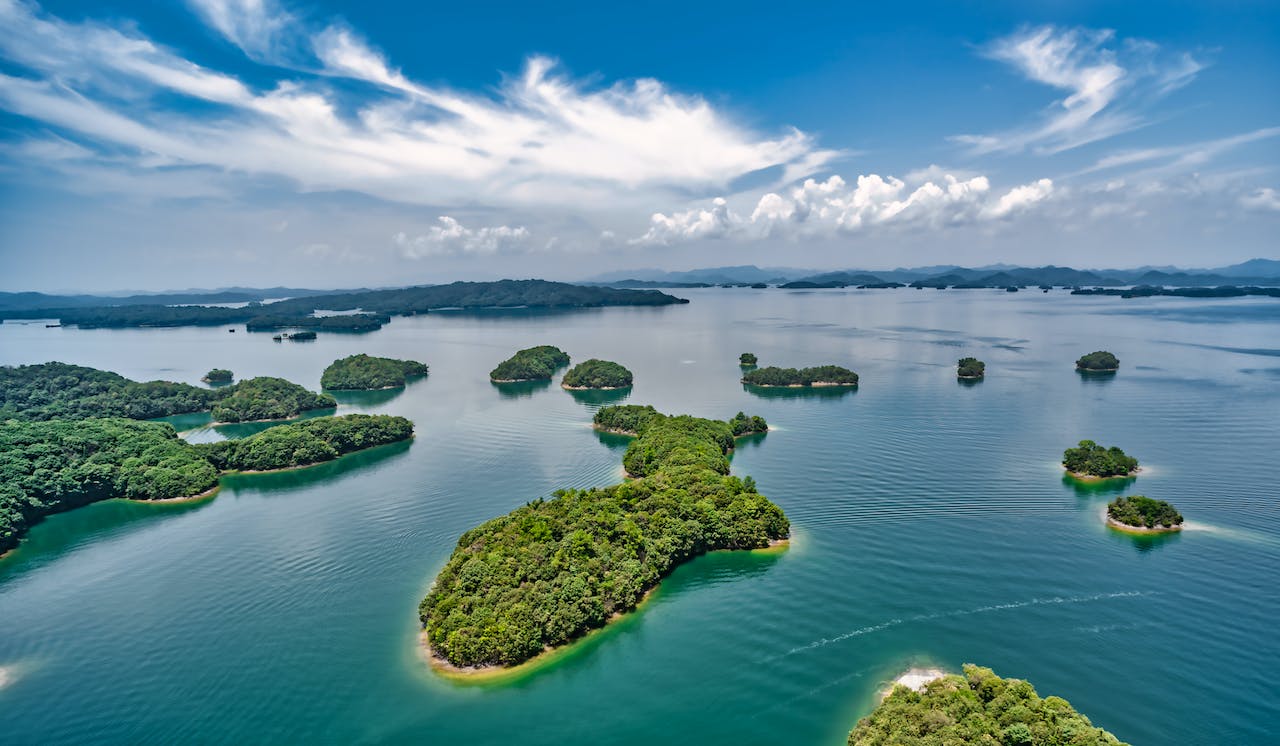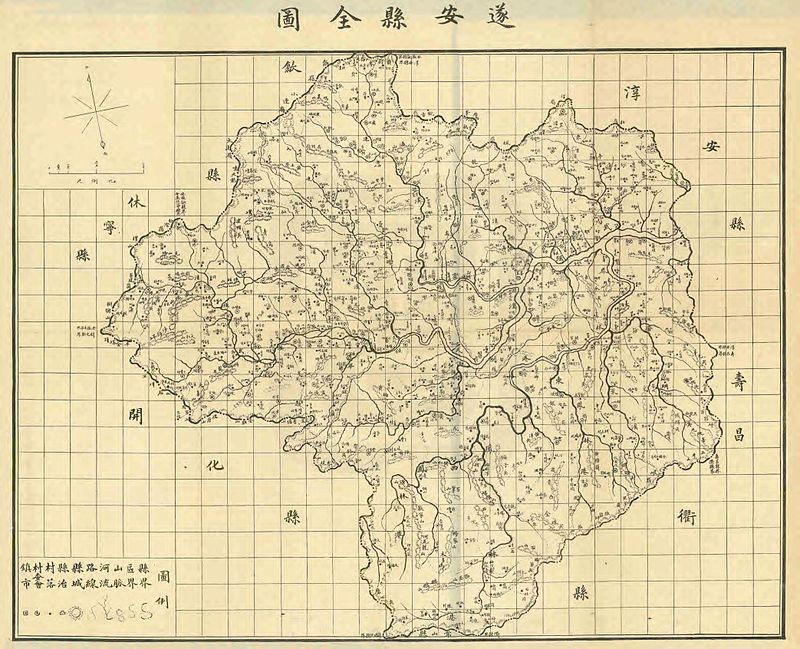Deep inside the Qiandao Lake in the Zhejiang Province of China, 400 km (250 miles) south of Shanghai, lies the ancient submerged city of Shi Cheng (Lion City). The city was built during the Eastern Han Dynasty (AD 25–200) and was first set up as a county in AD 208. The city was named Chi Cheng from the nearby Wu Shi Mountain, located just behind the city.
The city prospered as a thriving center for trade and culture during the Ming Dynasty (1368–1644) and Qing Dynasty (1644–1912). The city was ideally situated in a valley surrounded by mountains and was close to lakes and rivers, making it a hub for commerce and transportation.
The valley surrounding the city was flooded in 1959 to create the Qiandao lake (also known as Thousand Island lake) for the Xin’an River Dam project. Nearly 300,000 people had to relocate for the project, some of whom had families that had lived in the area for centuries.
The Lion City was rediscovered in 2001 when the Chinese government organised an expedition to find the remains of the ancient metropolis. In 2011, the Chinese National Geography published some never-before-seen photographs and illustrations which raised international interest for the lost city, with many calling it “the Atlantis of the East”.
Today, Shi Cheng remains submerged at a depth of 26-40 meters (85- 131 feet) and measures about half a square kilometer (123 acres). Expeditions have revealed that the city had five entrance gates, as opposed to the traditional four – with two western-facing gates as well as gates in the other cardinal directions. The city’s wide streets also have 265 archways, featuring preserved stonework of lions, dragons, phoenixes and historical inscriptions, some of which date back as far as 1777.
Even though it is submerged, Shi Cheng has remained well preserved as the water actually protects the ruins from wind, rain and sun erosion. The city isn’t yet fully mapped so the diving into it is considered exploratory and limited to only advanced divers who can visit it between April and November.
8 Interesting Facts About Shi Cheng
1. The Remains Of The City Are In Excellent Condition To This Day
The water that was used in submerging the city did not have any corrosive chemicals and it was not favorable to marine life growth. That is why up until today, the city of Shi Cheng remains to be in pristine condition.
As a result, when divers and researchers recently visited the underwater city of Shi Cheng, they discovered the well-preserved architectural features, exquisite carvings, and other relics that offered important insights into ancient Chinese history, culture, and architecture. Most of the city’s buildings, including the stone walls, steps, and arches, are still standing, and the carvings and inscriptions on the walls can still be seen.
The city of Shi Cheng is a remarkable and important archaeological site because of the superb preservation of the city’s ruins, which enables researchers and visitors to acquire knowledge about the customs, trade, and cultural heritage of the people who formerly lived there during the Ming and Qing eras. It has also become Shi Cheng, a well-liked vacation spot for divers and travelers eager to check out the ancient underwater city’s well-preserved ruins.
2. Even The Wood Structures In The City Are Impeccably Preserved
Most of us are probably aware that it is not often that wood survives the fragmentation process especially if it’s submerged in water. However, the wooden structures in Shi Cheng is an exception because they are still perfectly preserved, and most experts believe that it is because of the water condition and lack of underwater organisms and wildlife. In some way, the water helped in preserving the priceless artifacts and history of what once was a bustling city.
The underwater environment of Qiandao Lake, with its comparatively constant water temperature, low oxygen levels, and limited sunlight exposure, has helped to preserve the city’s ruins. Deep water provides an anaerobic environment due to the lack of oxygen, which has slowed down the degradation of organic materials like wood and helped preserve them in outstanding condition.
3. Most Architectural Structures In Shi Cheng Contains Mythology
Most of the architecture surrounding of Shi Cheng depicts its resident’s beliefs, which is why these structures are able to tell how the temples were used back in the city’s heyday. Even if the colors of the city have faded, the archways and statues still remained to be intact.
Many of the buildings in Shi Cheng were constructed during the Ming and Qing periods. They are typically decorated with exquisite carvings, inscriptions, and other artistic elements that represent scenes from Chinese mythology, folklore, and history. These architectural components often carry an abundance of symbolism and have significant cultural and religious meanings.
For instance, you can see carvings of famed mythical creatures like dragons, phoenixes, and qilins, which are considered as lucky and symbolize prosperity and good fortune in Chinese culture. These mythical beings are frequently shown in various positions and forms, conveying multiple meanings and messages. For instance, dragon carvings symbolize strength, power, and the emperor’s authority, whereas phoenixes represent beauty, elegance, and feminine vitality.
4. The City Still Has Not Been Mapped Out Completely
Even if it’s not the largest city in the world, Shi Cheng’s underwater remnants is still not fully mapped out. Experts say that it would take several years for divers to slowly cover every area of the city. This includes noting each structure, building, archway, home, and roads. Keep in mind that the whole city has been preserved and submerged in water, this means that there are a handful of structures and buildings that have to be explored.
The city is spread out over an area the size of 62 football fields, and mapping and exploring can be difficult in the underwater environment due to poor visibility. Modern tools, including remotely operated vehicles (ROVs), sonar imaging, and underwater mapping tools, are being employed to explore further and document the city’s buildings and relics.
Shi Cheng’s incomplete mapping adds to its mystery and intrigue, providing an opportunity for further research and information on history, architecture, and cultural relevance. It also highlights the need for continued research and conservation efforts to further uncover the secrets of this remarkable submerged city.
5. The Water Temperature And The City’s Full Submersion Are Accountable For The City’s Preservation
In Qiandao Lake, where Shi Cheng is situated, the water temperature ranges from 10 to 20 degrees Celsius (50 to 68 degrees Fahrenheit) all year round. The decomposition of organic materials, especially wood, which is often used in city constructions, has been slowed down by the cool and comparatively consistent water temperature. By preventing the growth of organisms that can lead to degradation and decomposition, the cold water has served as a natural preservative.
Even if it seems that sinking an entire city that was so rich in history was not the smartest move, the idea of using a man-made water source to sink it may have been a good move. Since the water temperature remains the same and never fluctuates, the structures in the city may not weaken anytime soon.
6. China Had Plans Of Launching Submarine Tours To The City
At some point, China thought that it would be a great idea to have the city of Shi Cheng opened to the general public for viewing purposes. Because of the sunken city’s exceptional preservation and distinctive underwater location, it has been suggested that tourists should be given access to explore the city of Shi Cheng using submarines or underwater drones.
These trips might allow tourists to get up close and personal with Shi Cheng’s historic buildings, sculptures, and artifacts without endangering the aquatic environment or putting the city’s structures at risk. However, all the plans were ticked off in fear that the frequency of the tour would damage the city.
7. Amazingly, The Water In The Lake Is Not The Clearest Water For Diving
Despite the exceptional preservation of the Shi Cheng underwater city, diving and underwater research are difficult due to the poor visibility of the water in Qiandao Lake, where the city is located. Even if there’s no marine life in the lake, the visibility in the water is quite low. This is more likely because of the ground composition and dirt that existed in the city before it was flooded. Aside from this, debris and dust from the ancient structures also contributed to the cloudiness of the water. This is one of the reasons why only experienced divers are allowed to explore Shi Cheng.
However, due to advancements in underwater mapping technologies, remote sensing, and other tools that can help with exploring and documenting submerged archaeological sites, research and exploration efforts have nevertheless been able to uncover and document significant portions of Shi Cheng despite the limited visibility.
8. Shi Cheng Used To Be One Of The Most Powerful Cities In All Of China
Around 25 to 200 AD, Shi Cheng was known to be the most powerful empire in China. The city was well known for its reliable salt production business and developed into a significant hub for trade and commerce as a regional political and economic center. The city served as a major transportation hub with a vast network of rivers and canals linking it to other regions of China. It was a significant trade and cultural exchange point because of its advantageous location alongside the ancient Xin’an River’s waterways.
In addition to its historical significance, Shi Cheng was renowned for its rich cultural heritage, which was represented by the abundance of temples, pagodas, and other artifacts. The city was embellished with elaborate wooden sculptures, exquisite stone carvings, and elegant buildings, demonstrating its prosperity and cultural importance. That is why its eventual flooding became a historical tragedy. History from both Qing and Ming dynasties was sunken along with the city.


